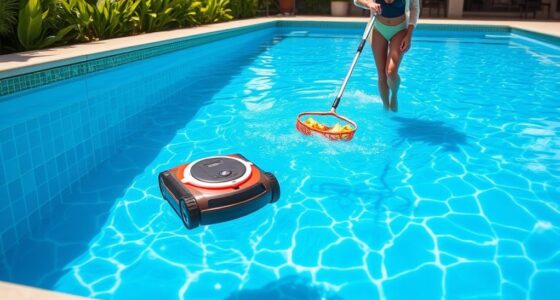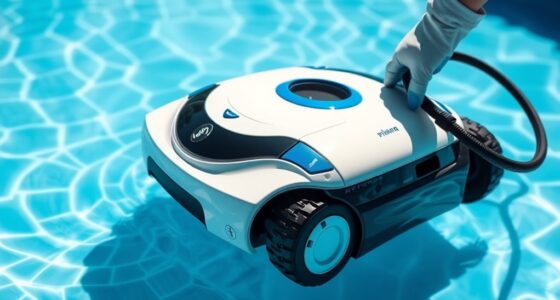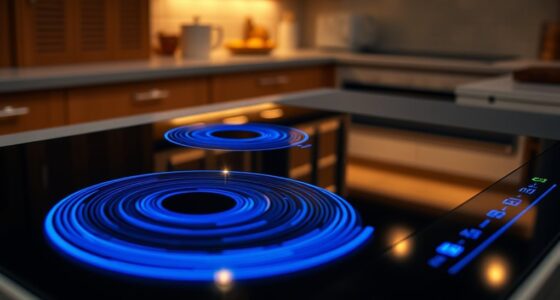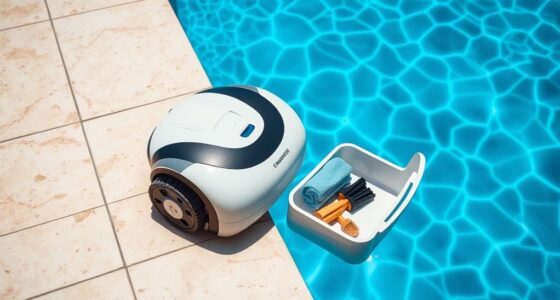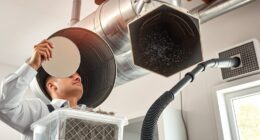When choosing between pressure and robotic pool cleaners, consider your pool’s size, shape, and cleaning needs. Pressure cleaners are more affordable and great for removing large debris, but they may miss fine dirt and struggle with complex designs. Robotic cleaners cost more upfront but offer thorough cleaning, handle tight spots, and operate quietly with less energy. To find the best fit, explore the benefits and features of each type as you continue to explore options.
Key Takeaways
- Pressure cleaners use pool pump pressure and are ideal for large debris but may miss finer dirt.
- Robotic cleaners are autonomous, providing thorough cleaning with advanced navigation and filtration.
- Robotic units are more energy-efficient, operate quietly, and often include smart features for convenience.
- Pressure cleaners are more affordable and suitable for bigger pools, while robots handle intricate designs better.
- Maintenance for pressure cleaners involves hoses and filters, whereas robotic cleaners require filter cartridge upkeep.

Are you wondering which type of pool cleaner suits your needs best—pressure or robotic? Deciding between these two options depends on understanding their differences through a thorough types comparison. Pressure pool cleaners operate by attaching to your skimmer or dedicated pressure line, utilizing the pressure generated by your pool’s pump to power their movement. They typically have a hose that connects to the system and a cleaning head that moves along the pool surfaces. Robotic pool cleaners, on the other hand, are self-contained units with their own motor and filtration system, allowing them to independently navigate your pool without relying heavily on your pool’s filtration system.
Choosing between pressure and robotic pool cleaners depends on your pool size, shape, and maintenance preferences.
When comparing these types, consider their cleaning efficiency and ease of use. Pressure cleaners usually excel at removing larger debris like leaves and twigs because they have strong suction and scrub brushes. However, they may miss finer dirt and require more manual intervention to reach all areas of the pool. Robotic cleaners tend to be more thorough, covering all surfaces with programmed navigation patterns, and they excel at capturing dirt, algae, and even tiny particles thanks to their advanced filters. They also tend to be more energy-efficient and quieter during operation. Additionally, robotic cleaners often come with smart features like scheduling and app control, which can further simplify maintenance.
Maintenance tips for pressure and robotic cleaners vary, but both require regular upkeep to ensure top performance. For pressure cleaners, check the hoses for leaks and blockages frequently, as these can reduce pressure and cleaning effectiveness. Clean the brushes and filters to prevent buildup of debris, which can cause the cleaner to work harder or malfunction. Robotic cleaners need their filter cartridges or bags emptied regularly, especially after heavy use, and the brushes should be inspected for wear and replaced if necessary. Additionally, keep the robot’s tracks or wheels free of debris to maintain smooth navigation. Proper maintenance practices extend the lifespan and performance of your cleaner significantly.
Choosing between pressure and robotic pool cleaners also involves considering your pool size and shape. Pressure cleaners are often more affordable and suitable for larger pools, but they might struggle with complex shapes or tight corners. Robotic cleaners, while more expensive upfront, are generally better at handling intricate pool designs and are easier to operate with minimal setup. Think about your maintenance routine and how much time you’re willing to dedicate to upkeep—robotic cleaners tend to require less manual intervention once set up. It’s also beneficial to evaluate the energy consumption of each type to reduce operational costs over time.
In the end, your decision hinges on balancing your pool’s specific needs, your budget, and how much effort you’re prepared to invest in maintenance. Both types have their strengths and limitations, but understanding their differences through a thorough types comparison and following proper maintenance tips will help you choose the best cleaner for your pool.
Frequently Asked Questions
Are Pressure and Robotic Pool Cleaners Suitable for All Pool Sizes?
Your pool size influences whether pressure or robotic cleaners are suitable. Larger pools may challenge some models due to pool size limitations, requiring more powerful units or multiple cleanings. Smaller pools often fit most cleaners comfortably. Cost considerations also matter; robotic cleaners tend to be pricier upfront but save time, while pressure cleaners usually cost less but may need more maintenance. Assess your pool size and budget to choose the best option.
How Energy-Efficient Are Pressure Versus Robotic Pool Cleaners?
Did you know robotic pool cleaners typically use 15-20% less energy than pressure cleaners? When comparing energy consumption, robotic models are more efficient because they operate on low voltage and auto-adjust cleaning cycles. This results in better cleaning efficiency with less power use. So, if you’re looking to save on energy bills while keeping your pool spotless, robotic cleaners are a smarter, more eco-friendly choice.
Can Pressure Cleaners Handle Debris Like Leaves and Twigs?
You might wonder if pressure cleaners can handle debris like leaves and twigs. These cleaners are generally effective at leaf accumulation and twigs removal, thanks to their powerful jets and spinning brushes. However, large debris could clog the system or get trapped. Regularly checking and clearing the intake guarantees ideal performance. Overall, pressure cleaners are quite capable of managing typical debris, but heavy or bulky items may require manual removal.
What Is the Average Lifespan of Each Type of Cleaner?
You want to know how long each cleaner lasts. On average, pressure cleaners need more frequent maintenance and might have higher repair costs, lasting around 5 to 8 years. Robotic pool cleaners typically have a longer lifespan, around 8 to 10 years, with less maintenance and lower repair costs. Regular upkeep can extend their life, so consider your maintenance frequency when choosing the right cleaner for your pool.
Do Robotic Cleaners Require Professional Installation or Maintenance?
Robotic pool cleaners generally don’t require professional installation; you can usually set them up with DIY instructions. Maintenance is straightforward, but you should occasionally check for software updates to guarantee peak performance. While most models are user-friendly, some advanced features may need a bit of troubleshooting or minor adjustments. Overall, robotic cleaners are designed for easy use, making maintenance simple and hassle-free for homeowners like you.
Conclusion
When choosing between pressure and robotic pool cleaners, consider that robotic models can clean up to 50% faster and with less energy than traditional pressure cleaners. This efficiency means less time and effort on your part, making maintenance simpler. If you want a hassle-free experience, robotic cleaners are a smart choice. With their advanced technology, you’ll enjoy a cleaner pool in less time, proving that investing in a robotic cleaner can truly pay off in convenience and efficiency.


